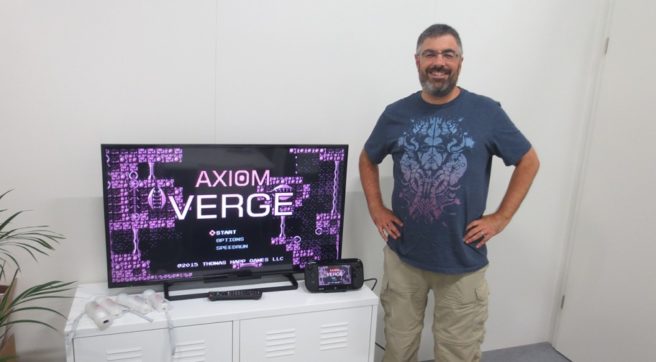Nintendo of Europe Axiom Verge developer interview with Dan Adelman
At gamescom last month, Nintendo of Europe conducted an interview with Dan Adelman, a former employee of Nintendo of America and currently the business partner of Thomas Happ, who created the Metroid-like game Axiom Verge, which is out now on Wii U. The full interview can be found here – below are a couple of interesting excerpts from the interview:
Nintendo of Europe: It sounds like Tom had a very strong vision of what he wanted the game to be from the start. For example, the heads-up display in the game is very minimalist in a similar way to Metroid and other retro games. Is that kind of aesthetic part of the design philosophy for this game?
Dan Adelman: Yeah, I think a lot of Tom’s philosophy in terms of game development is about not overloading the player with information. So, for example, when you start out in Axiom Verge, you start off in the middle of a room, and you can try to go either right or left, and this actually takes inspiration from Metroid. You try to go to the right, and you’re blocked, so you have no choice but to go to the left and then, instead of having a tutorial that says, “Go here. Press this button to jump,” you’re basically in a place where you need to jump and you try all the buttons and you figure it out.
I know he put a lot of effort into teaching the player how to play without making it a tutorial, or writing up a lot of text, and so there were only like one or two places where I remember he struggled. When we brought the game to PAX East, we observed people playing the game. There’s one button – the L Button – that you can hold down in order to lock your position and aim in any direction, and at different events there were a lot of people who just didn’t get it. They didn’t pick it up on their own, so that was one instance where Tom actually had to add in a line explaining how to do it.
NoE: Was it tricky to get the difficulty just right? Did you ever find people saying the game was too tough?
DA: Not too many. I think, at shows when people just pick the game up cold and they don’t know anything about it, they’ll fail a lot and give up too easily. I think when people play at home, and they sit down and try to digest it, they’ll learn pretty quickly.
NoE: It’s got a learning curve like all those classic games.
DA: Yeah, like anything else. One thing I actually really like about the game is that, if you take your time as you’re playing it, there’s usually a way to destroy the enemy in a way that means you’re still safe, or just avoid the enemy entirely.
So if you tried to run right through everything and just keep blasting like in Contra, you’ll probably get taken out pretty quickly, but if you think, “Alright, there’s an enemy up ahead. I’m going to climb up on this platform and shoot down on him. He can’t reach me up here!” If you notice those environmental cues, you can actually make things a bit easier on yourself. It’s only later in the game where you have to fight creatures at close-quarters.
NoE: Does Axiom Verge take advantage of Wii U’s unique hardware features in any way?
DA: Yeah, there are a couple of really important ways. My favourite is the fact that the map is on the Wii U GamePad touch screen at all times. I know that the first time I played Axiom Verge, I had to keep pausing the game to see where I needed to go next. A lot of modern games in this genre will just draw an arrow and say, “Go here next, and then go here next,” and it holds your hand. This game doesn’t do that. You figure out where you need to go next by looking at the map and saying, “Oh, where have I not explored yet? Let’s try to get there”. I was constantly going back and forth, and back and forth. Having the map always available makes it very user-friendly. The other feature, of course, is off-TV play, which is very convenient for people who have to share a TV – they’ll still be able to play!
Source
